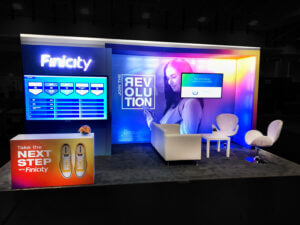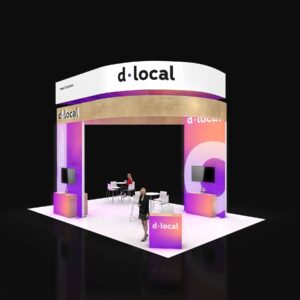
7 Ways to Improve Your Las Vegas Trade Show Display
In one recent year, Las Vegas welcomed more than 6.3 million trade show and convention attendees, according to the city’s tourism bureau. Of the 20,000-plus industry gatherings happening annually, the largest draw in hundreds of thousands of visitors and many thousands of exhibitors.
Las Vegas trade show exhibits that attract the most attention inevitably produce impressive returns on investment for their sponsors. Standing out on any trade show floor, though, often proves more difficult than might be expected.
Fortunately, there are always ways to add to the draw, appeal, and overall effectiveness of any trade show display. Read on to learn about seven of the most potent.
1. Leverage Interactive Technology

Digital technology has become a major part of everyday life for just about everyone, but relatively few trade show exhibits really strive to make the most of it.
Going beyond static displays to include interactive technology is a proven way to pull in more visitors and keep them engaged. Some of the approaches that most often succeed at trade shows in Las Vegas include:
Touchscreen Displays: Even something as basic as a PowerPoint deck displayed on a touchscreen can be more engrossing than a non-interactive display. Simply allowing visitors to proceed at their leisure through presentations will often make them more likely to stick around. Freely available, well-established frameworks make it possible for developers to turn out highly cost-effective trade show apps ready for interactive touchscreen use.
Virtual Reality Exhibits: Affordable but highly capable virtual reality (VR) systems like Facebook’s Oculus Rift and the HTC VIVE make for a natural fit for trade shows. While it will normally take some investment to have a VR exhibit developed, the immersion that results can become the defining feature of a show for booth visitors. Taking visitors away from the bustle of a trade show floor and into an artificial reality for even a few minutes will always make an impression.
Augmented Reality: Augmented reality spices up everyday existence by mixing it with digitally rendered extras. Augmented reality trade show apps most often combine real-time footage or static images obtained from digital cameras with product replicas and such. Augmented reality turns out to be a more flexible and natural feeling alternative to VR, in many cases.
2. Do More With Your Lighting
Many trade show exhibits feature utilitarian lights that were chosen for their functional traits and little else.
The right type of lighting, though, can liven up almost any trade show exhibit and make it more noticeable amidst the clutter. Some of the types of lighting that can be used to enhance trade show booths include:
Spotlights: The ambient lights that ward off the dark in large trade show halls can be twenty, thirty, or even more feet overhead. That creates a diffuse, even sort of lighting which is not always best for particular exhibits. Having even a few spotlights available to point and focus as appropriate can help an entire booth stand out.
Customized Fixtures: Even highly functional lighting fixtures do not need to be boring. Shades shaped to reflect or recall distinctive brand assets can make a trade show exhibit a lot more memorable. In some cases, simply having an unusual looking fixture hanging overhead will empower a booth to draw trade show attendees from afar.
Mood Lights: Colored lights can perk up the look of an exhibit without interfering with the feeling of a brand. LED mood lights that are set up to sift through a carefully chosen spectrum can subtly attract attention without being imposing.
3. Explore the Third Dimension
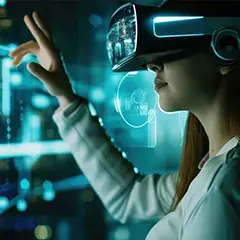
All trade show booths are inherently three dimensional, but many ends up looking and feeling pretty flat, nonetheless.
Exhibits that make good use of the third dimension tend to stand out in more ways than one. Some of the best ways to add a new dimension to a booth or exhibit include:
CNC-Milled Or 3D-Printed Logos: Logos displayed on LED screens or simple signs are found in almost all trade show booths. Having three-dimensional logos and other assets turned out via CNC or 3D printing will add a distinctive flair at many trade shows. In the past, opting for a 3D logo most often meant needing to keep things simple. That is no longer the case at all, with modern mills and printers being able to recreate impressive levels of detail and complexity.
Two-Level Booths: Opting for a sizable booth means more than being able to stretch out horizontally. Booth sizes of 20′ by 20′ and beyond can often accommodate exhibits with two separate levels. That extra, elevated level can be used for anything from private meeting space to a comfortable lounge area for visitors to relax in. In just about every case, two-level exhibits attract more than twice the attention than those that stick close to the floor.
4. Rethink Your Layout

Surprisingly many trade show exhibits end up being difficult to navigate or even to enter from the surrounding area.
Exhibit layouts should be designed to allow for the smooth flow of foot traffic but also to encourage those who wish to stay planted to do so comfortably
In many cases, it will be possible to improve the layout of a booth without even needing to invest in any additional assets. The best way to figure out how to upgrade any booth’s layout is to watch what happens when the crowds are thick and take some notes for later analysis.
5. Get to Know Your Audience Better

Sales teams and trade show managers almost always spend lots of time thinking about the audience they need to target. In many cases, though, too much of a focus on business leads to some missed opportunities.
While it will always be best to err on the side of professionalism, adding a bit of audience-appropriate personality to an exhibit can make it a lot more successful. Some of the most frequently productive points of focus include:
- Popular Hobbies: Many industries attract people who tend to like the same types of recreation. Whether that means golf or fishing and hunting, acknowledging such inclinations with a trade show exhibit can pay off.
- Inside Jokes: A simple reference to a joke or trope well-known and -liked by industry insiders can earn an exhibit many referrals over the course of a trade show. Such touches should not normally be the focus of an exhibit at all, and they do not need to be in order to have impressive effects.
6. Become More Colorful
A strong, cohesive brand is always a valuable asset. Most trade show displays stick closely to branded color schemes, and that can be most appropriate.
Working in an extra splash of vibrant color here and there, though, can easily make a booth more noticeable. Companies like Exponents regularly use color to help booths attract attention on crowded trade show floors in Las Vegas. It is often practical to remain faithful to a brand’s identity while strategically making use of more color in places like:
Flooring: One way to add some color to an exhibit without breaking from brand standards is to add some eye-catching flooring. Wooden-look flooring will rarely feel out of place and can help make an exhibit feel more colorful. A carpet whose hue complements and extends a brand’s palette can easily do the same.
LED Walls: Having an entire wall or other large space filled with moving, colorful images is another way to use color to great effect. While LED walls and other large-format displays have become common enough that the incremental impact can be dampened, they are still frequently worth considering.
7. Be Inspired by the Competition
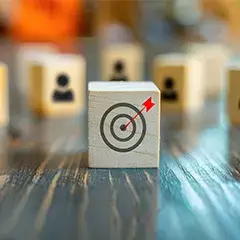
Every industry is different, and trade show tactics that work for one sort of business sometimes fall flat in others. Just about every expo, though, will feature some buzz about at least a couple of exhibits that were particularly popular and successful.
Taking notes and leveraging what you learn for the next trade show can pay huge dividends. It is not necessary to steal competitors’ exhibition-related ideas, and it is generally better not to do so.
Instead, think in more general terms about how the same sort of success could be recreated in a new and surprising way. If a competitor drew crowds with free massage chair sessions, come up with another affordable indulgence that no one has offered yet.
If a competing sales team dreamed up a new game that had passersby stopping to watch, encourage your own staffers to do some brainstorming. Paying attention to what works for other companies at one trade show will make it much easier to succeed at the next.
8. There are Always Ways to Improve
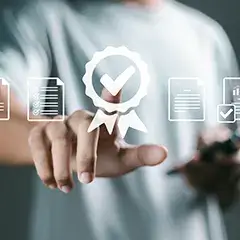
Just about every team of trade show representatives holds regular after-the-fact meetings to talk about how to perform better at the next event.
Exhibits themselves often receive short shrift in such discussions, with their particulars sometimes even being taken as set in stone.
In reality, though, there are almost always some simple and accessible ways to improve the real-world performance of any trade show booth display. Strategies like those above have helped make many exhibits in Las Vegas far more successful.
